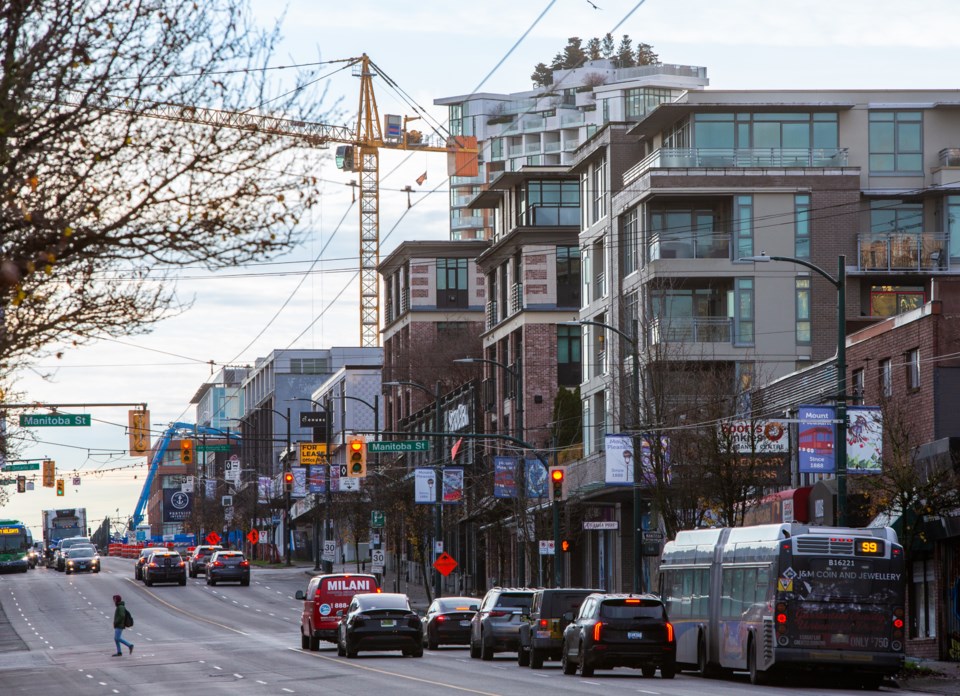A transformative 30-year plan approved by Vancouver’s previous city council in 2022 for Broadway and its corridor has attracted significant interest from developers, with 146 projects in the development pipeline.
Of the 146 projects, 117 are residential or mixed-use residential, comprising a total of 22,842 homes—540 for social housing, 3,639 below-market rental, 16,307 market rental and 2,356 strata units.
A total of 29 projects are in the formal rezoning enquiry stage, 68 in the rezoning applications stage and 20 at the approval stage. Another 25 are seeking development permits, three are awaiting building permits and one has reached the occupancy permit stage.
The data was relevant May 5, when Josh White, the City’s general manager of planning, wrote a memo to council. That memo was posted to the City’s website this week and is the most recent data available on the plan, according to an email Friday from the City’s communications department.
The data does not include, for example, a series of approvals from council this week for rental towers at 254 East 12th Ave., 1855 West Second Ave. and 2079-2085 West Fifth Avenue.
The total number of units among those three projects is 516.
A controversial three-tower proposal for Commercial Drive and Broadway was also recently approved, although it just falls outside the Broadway Plan area.

Broadway Subway opens in 2027
Since the implementation of the Broadway Plan in September 2022, White’s memo says 24 rezoning applications were approved by council. The plan covers the area within Vine Street to Clark Drive, and First Avenue to 16th Avenue.
The stated goal of the plan is to prioritize market and below-market rental housing, and social housing near transit hubs and corridors to improve access to jobs, school and community amenities for renters earning low and moderate incomes.
The new Broadway Subway is scheduled to open in 2027.
'Quite astounding'
Michael Geller, a veteran planner and retired developer, said in an email Friday that his initial observation of the data is that the number of applications and approvals is dramatically more than anticipated when the plan was first announced.
“However, as others have pointed out, you can't live in an approval,” Geller said. “In this regard, it is significant that so far, only one project has reached the [occupancy] permit stage. I find this quite astounding. I would have expected more.”
He said he was also surprised to see the number of below market units—assuming all of the projects proceed—will be only 1.6 times the number of existing affordable units.
“So while the [plan] has the potential to dramatically increase the supply of rental housing—if and when these projects are completed and occupied—the number of below market rental homes is not likely going to be much larger, or indeed as large as the number of affordable units in older buildings,” Geller said.
Meanwhile, he added, all of this is causing great angst for those living in older apartment buildings and along “lovely, leafy character streets” a few blocks from Broadway.
“Is it worth it? I don't think so,” he said. “I also think it's time for the City to put in place a moratorium on those projects far away from Broadway, especially those that will result in the demolition of older apartment buildings.”
White’s memo includes data regarding the City’s Tenant Relocation and Protection Policy (TRPP) and says 86 per cent of tenants living at a site undergoing rezoning or in the development permit stage are eligible for the policy.
For the affected tenants, that could mean compensation, right of first refusal to return to the new building and moving expenses.
White’s memo says rezoning and development permit applications for which the City has TRPP eligibility data impacts 42 sites with primary rental housing, comprising 1,375 existing rental units and another 10 sites with secondary rental housing, comprising 98 existing rental units.
'Impacts of displacement'
Coun. Pete Fry said in a text message Friday that he was happy to see data on the TRPP included in White’s memo—a request he had previously made to track the number of tenants affected by redevelopment.
“Because, for me, that is one of the more critical considerations around the Broadway Plan implementation—that is to say the impacts of displacement on existing tendencies,” Fry said.
His other observation of the data was the number of rezoning inquiries made compared to the development and building permits issued. He described the imbalance as “a lot of placeholding.”
“I think developers are getting their foot in the door to secure their spot on the block, as it were, given the tower per block limitations,” Fry said.
“What we aren’t seeing is a ton of shovels in the ground on these projects. We are hearing [this is] largely due to economic uncertainty around tariffs, population growth, foreign students, etc.”
Note: This story has been updated to clarify that the recently approved towers for Commercial and Broadway do not fall within the Broadway Plan area. The lead photo with the story has also been replaced.
X/@Howellings




